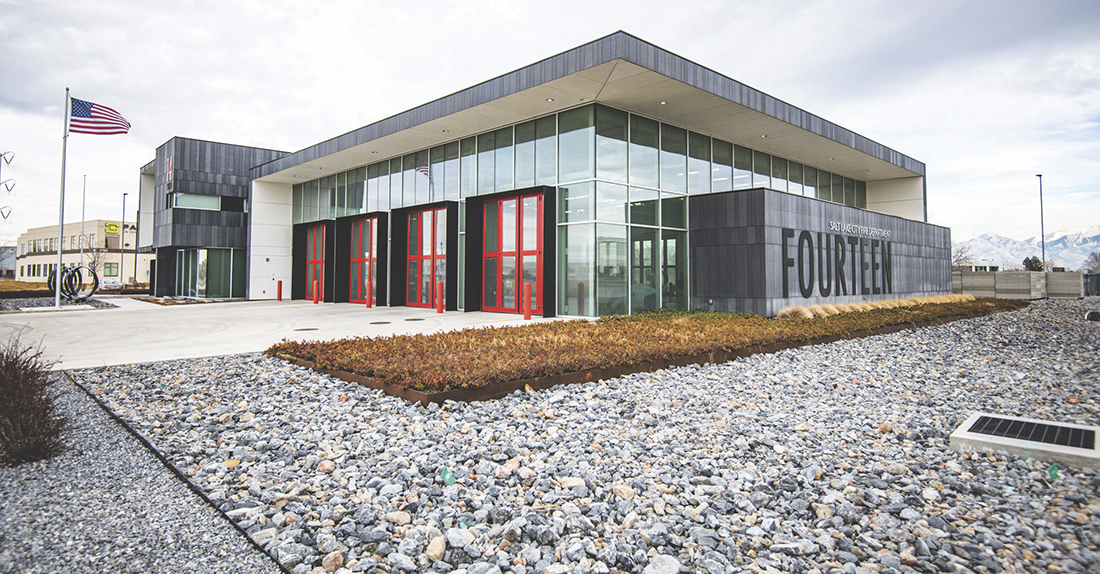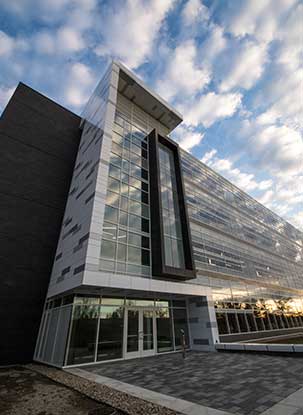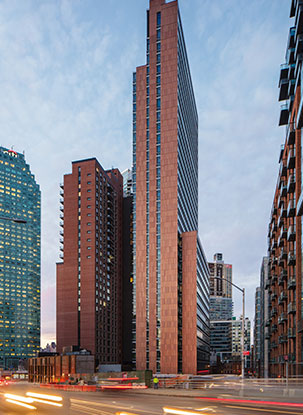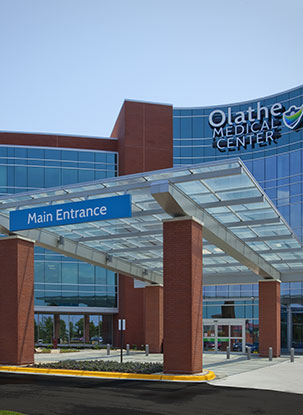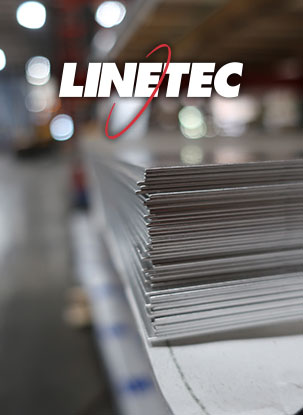
Stretch forming is a very accurate and precise method for curving metal extrusions. The level of precision is so high that, in most cases, even intricate multi-components and snap-together curtainwall components can be formed without loss of section properties or original design function. Stretch forming capabilities include portions of circles including half-circles and eyebrows, ellipses and arched shapes. These shapes can be formed with straight leg sections at one or both ends of the curve. This method of curving eliminates several conventional fabrication and welding steps.
Stretch forming is a metal forming process in which the extrusion or part is kept under constant tension while stretched and bent simultaneously over a die in order to form contoured parts. The variety of shapes and cross sections that can be stretch formed is almost unlimited. Window systems, skylights, storefronts, signs, flashings, curtainwalls, walkway enclosures, and hand railings can be accurately and precisely formed to the desired shapes.
 The basic machine design has two arms or carriage beams that hold multiple-positioning gripping jaws. The jaws are attached to hydraulic tension cylinders that provide the stretch of the extrusion. The arms swing by rotating on large machined pins with bearings, thus allowing the extrusion to wrap around and against the forming die. This produces perfectly contoured products, while limiting or even eliminating wrinkling inside the arc.
The basic machine design has two arms or carriage beams that hold multiple-positioning gripping jaws. The jaws are attached to hydraulic tension cylinders that provide the stretch of the extrusion. The arms swing by rotating on large machined pins with bearings, thus allowing the extrusion to wrap around and against the forming die. This produces perfectly contoured products, while limiting or even eliminating wrinkling inside the arc.
Close and consistent tolerances, no surface marring, no distortion or ripples, and no surface misalignment of complex profiles are important benefits inherent in stretch forming (given understandable tightness of radius limitations on some shapes). A smooth and even surface results from the stretch forming process.
Structural or Load-Bearing Application vs. Non-Structural Application
 Aluminum has proven itself as a suitable material for load bearing structures for more than 100 years. However, the application of the parts being curved dictates how the curving process will need to be carried out.
Aluminum has proven itself as a suitable material for load bearing structures for more than 100 years. However, the application of the parts being curved dictates how the curving process will need to be carried out.
After being pushed through an extrusion press, extrusions are generally cut and then placed into a tempering oven to harden and give them their structural integrity. When extrusions are fully tempered to a T5 of T6 temper they are difficult to curve. If a customer desires to curve parts that have been fully tempered the parts will need to be annealed prior to curving. When a part is annealed it is placed in a large oven and heated to a very high temperature for a specific period of time. Annealing makes the extrusion soft again, enabling it to be curved. Once an extrusion is annealed, it cannot cost-effectively be re-tempered. In applications where the parts are expected to carry a structural load, or are desired to have another structural application, annealing is generally not an acceptable practice.
For structural or load-bearing applications, best practice is to have extrusions tempered to a soft state T1, T4 or to a T52 state. Material tempered to a T1 or T4 temper can be bent without annealing, and can then be tempered (hardened) after the curving process to a T5 or T6 temper typical in structural applications. T52 is a very stable temper and can be curved without annealing, and it maintains its properties after curving without the need for tempering.
Stretch Formings’ Effect on Finishing

If an extrusion has been painted or anodized, and has been tempered to a T5 or T6 hardness, the parts will need to be annealed. Because of the high heat associated with the annealing process, paint finishes will likely burn and anodize finishes will likely discolor or craze (crack). For this reason, when parts require annealing it is best to finish after the curving process has been completed.
 For extrusions that have been tempered to a T1, T4, or T52 hardness, parts can be finished prior to curving. However, customers should expect some marring or slight damage to the finished surface due to the parts being “stretched” across a hard die surface during the curving process. Again, depending on the tightness of the radius anodic coatings may also craze or discolor as a result of being curved.
For extrusions that have been tempered to a T1, T4, or T52 hardness, parts can be finished prior to curving. However, customers should expect some marring or slight damage to the finished surface due to the parts being “stretched” across a hard die surface during the curving process. Again, depending on the tightness of the radius anodic coatings may also craze or discolor as a result of being curved.If the T1 or T4 tempered extrusions require oven-aged tempering after curving, the high heat will likely damage the coating.
 Regardless of the effect the curving process has on the finish, all manufacturer and applicator warranties are generally voided when extrusions or brake metal are finished prior to curving. To obtain the best finish quality and keep parts fully warranted, it is best to finish after curving regardless of the temper of the extrusion.
Regardless of the effect the curving process has on the finish, all manufacturer and applicator warranties are generally voided when extrusions or brake metal are finished prior to curving. To obtain the best finish quality and keep parts fully warranted, it is best to finish after curving regardless of the temper of the extrusion.
It should also be noted that on parts that require a poured thermal break, it is also best practice to have extrusions thermally broken after curving so there is no cracking of the thermal break, and the manufacturer’s warranties stay intact.
Learn more about Linetec’s capabilities on our website or contact us at sales@linetec.com or 888-717-1472.
